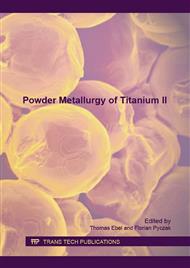[1]
Jackson, C., The Process, in Perspectives in Powder Metallurgy. New Methods for the Consolidation of Metal Powders, H. Hausner, K. Roll, and P. Johnson, Editors. 1967, Plenum Press.
Google Scholar
[2]
Schwartz, S., P. Quirmbach, and M. Kraus, Solvent Debinding Technology for a Continuous 316L MIM Production, in PIM Compilation II. Molding, Debinding, Sintering, MPIF, Editor. 2007, Metal Powder Industries Federation: Princeton, NJ.
Google Scholar
[3]
Schofalvi, K., Low Contamination Binders for Reaction Sensitive Alloy Applications, in PIM Compilation I. Powders, Binders and Feedstocks, MPIF, Editor. 2007, Metal Powder Industries Federation: Princeton, NJ.
Google Scholar
[4]
Myers, N., R. Baijal, and P. King, Sintering of PIM Fe-2Ni-0. 8C, in PIM Compilation II. Molding, Debinding, Sintering, MPIF, Editor. 2007, Metal Powder Industries Federation: Princeton, NJ.
Google Scholar
[5]
Guha, S., MER introduces golf clubs using superfine powders. Metal Powder Report (1997).
DOI: 10.1016/s0026-0657(97)86815-4
Google Scholar
[6]
Gai, G., et al., Particle shape modification and related property improvements. Powder Technology 2008. 183: pp.115-121.
DOI: 10.1016/j.powtec.2007.11.026
Google Scholar
[7]
Herranz, G., et al., Development of new feedstock formulation based on high density polyethylene for MIM of M2 high speed steels. Powder Metallurgy, 2005. 48(2).
DOI: 10.1179/003258905x37828
Google Scholar
[8]
Banerjee, S. and C. Joens, A Comparison of Techniques for Processing Powder Metal Injection Molded 17-4 PH Materials. (2008).
Google Scholar
[9]
German, R., Conceptual Optimization of Titanium Powder Injection Molding, in Advances in Powder Metallurgy & Particulate Materials, M. Bulger and B. Stebick, Editors. 2010, Metal Powder Industries Federation: Hollywood, Florida. p.11.
DOI: 10.31399/asm.hb.v07.a0006055
Google Scholar
[10]
Froes, S., Getting better: big boost for titanium MIM prospects. Metal Powder Report, 2006: p.4.
DOI: 10.1016/s0026-0657(06)70762-7
Google Scholar
[11]
JPMA, 2011 Report for MIM Market. 2011, Japan Powder Metallurgy Association: Tokyo.
Google Scholar
[12]
Kryachek, V.M., D.A. Levina, and L.I. Chernyshev, Powder Metallurgy Abroad, Developmental Trends in European Powder Metallurgy. Powder Metallurgy and Metal Ceramics, 2007. 46(11-12).
DOI: 10.1007/s11106-007-0091-8
Google Scholar
[13]
Heaney, D. and R. German, Advances in the Sintering of Titanium Powders, in Euro PM2004. (2004).
Google Scholar
[14]
Li, Y., X.M. Chou, and L.M. Yu, Dehydrogenation debinding process of MIM titanium alloys by TiH2 powder. Powder Metallurgy, 2006. 49(3).
DOI: 10.1179/174329006x95338
Google Scholar
[15]
Oberg, E., et al., Machinery's Handbook. 29 ed, ed. C. McCauley. 2012, New York, NY: Industrial Press Inc.
Google Scholar
[16]
German, R., Coarsening in Sintering: Grain Shape Distribution, Grain Size Distribution, and Grain Growth Kinetics in Solid-Pore Systems. Critical Reviews in Solid State and Materials Sciences, 2010. 35: p.43.
DOI: 10.1080/10408436.2010.525197
Google Scholar
[17]
Cremers, D. and L. Radziemski, Introduction, in Handbook of Laser-Induced Breakdown Spectroscopy. 2013, John Wiley & Sons Ltd: West Sussex, UK. p.3.
Google Scholar
[18]
Singh, J.P. and S.N. Thakur, Fundamentals of Laser Induced Breakdown Spectroscopy, in Laser-Induced Breakdown Spectroscopy, J.P. Singh and S.N. Thakur, Editors. 2007, Elsevier: Oxford, UK. p.3.
DOI: 10.1016/b978-044451734-0.50004-1
Google Scholar
[19]
Ready, J.F., Effects Due to Absorption of Laser Radiation. Journal of Applied Physics, 1965. 36(2): pp.462-468.
Google Scholar
[20]
Ewart, P., D. Zhang, and S. Ahn, Injection moulding titanium powders; feedstock compounding, homogeneity and handling strength. Powder Injection Moulding International, 2011. 5(2): p.6.
Google Scholar
[21]
Leme, F.O., et al., Effect of pulse repetition rate and number of pulses in the analysis of polypropylene and high density polyethylene by nanosecond infrared laser induced breakdown spectroscopy. Applied Surface Science, 2012. 258(8): pp.3598-3603.
DOI: 10.1016/j.apsusc.2011.11.122
Google Scholar
[22]
Bogaerts, A., et al., Laser ablation for analytical sampling: what can we learn from modeling? Spectrochimica Acta Part B: Atomic Spectroscopy, 2003. 58(11): pp.1867-1893.
DOI: 10.1016/j.sab.2003.08.004
Google Scholar
[23]
Cremers, D. and L. Radziemski, Basics of the LIBS plasma, in Handbook of Laser-Induced Breakdown Spectroscopy, D. Cremers and L. Radziemski, Editors. 2013, John Wiley & Sons Ltd: West Sussex, UK. p.29.
DOI: 10.1002/0470093013
Google Scholar
[24]
Thakur, S.N., Atomic emission spectroscopy, in Laser-Induced Breakdown Spectroscopy, J.P. Singh and S.N. Thakur, Editors. 2007, Elsevier: Oxford, UK. pp.44-48.
DOI: 10.1016/b978-044451734-0.50005-3
Google Scholar
[25]
Panne, U., et al., Analysis of glass and glass melts during the vitrification process of fly and bottom ashes by laser-induced plasma spectroscopy. Part I: Normalization and plasma diagnostics. Spectrochimica acta, Part B: Atomic spectroscopy, 1998. 53(14): p.1957-(1968).
DOI: 10.1016/s0584-8547(98)00238-9
Google Scholar


